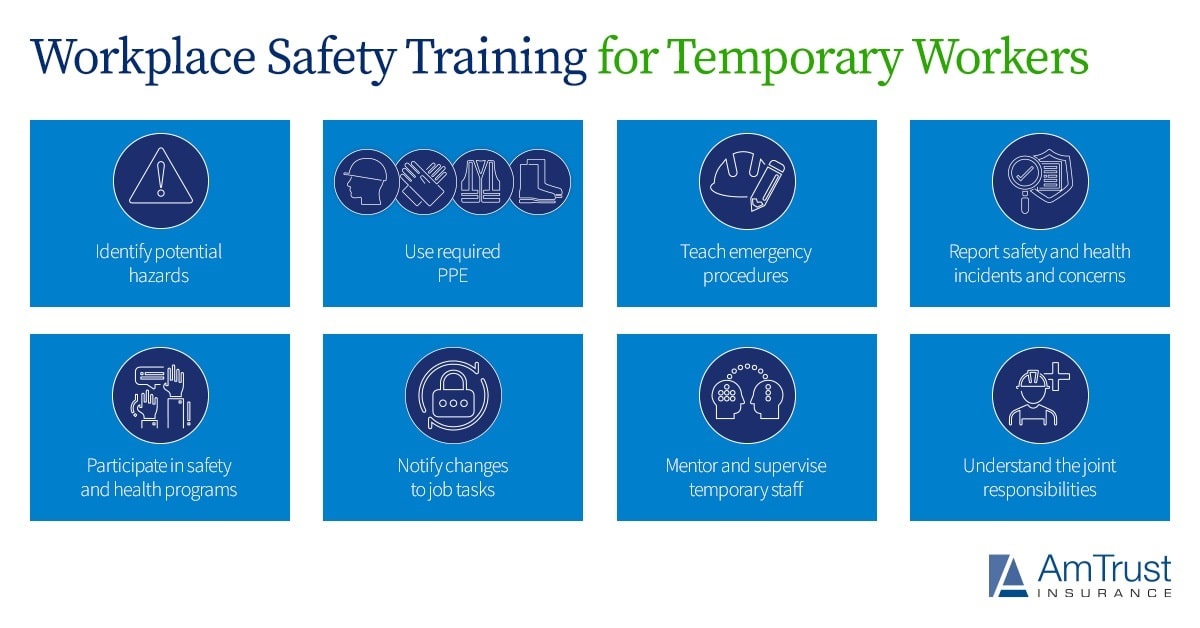Summary: Temporary workers are an essential component of a business’s productivity. It is vital to have safe work environments for both permanent and temporary staff. NIOSH recently released updated workplace health and safety best practices for those employers and quick worker staffing companies. We delve into each section of the guidelines to help keep your workers safe and healthy. Keeping Temporary Workers Safe on the Job
Temporary workers are those paid by a staffing agency and assigned to a host employer for short- or long-term assignments. The Occupational Safety and Health Administration (OSHA) states that host employers are responsible for
protecting the health and safety of all workers, both temporary and permanent.

An analysis of workers’ compensation data shows that the risk of
work-related injuries is higher for temporary workers than for permanent employees. The factors contributing to this
elevated potential for injuries include:
- Unfamiliarity with the workplace, jobs or tasks
- Lack of communication between the employer, staffing agency and temporary worker
- Insufficient temporary worker training
- Unexpected changes to the temporary worker’s job duties that are not reported to the staffing agency
While temporary employees may be at an increased risk for injury or illness on the job, any worker can be at risk if their workplace is unsafe or they have not received adequate training or communication. These issues can also impact the employer’s bottom line due to productivity issues, high injury costs, poor customer service and a negative reputation.
NIOSH Updated Guidelines for Temporary Workers

In 2014, OSHA and the National Institute for Occupational Safety and Health (NIOSH) issued “
Recommended Practices: Protecting Temporary Workers,” which provides procedures that hiring employers and staffing companies should follow to protect temporary workers. Employers can promote a safe and productive workforce by integrating these best practices into their workplace safety programs and procedures.
NIOSH and the National Occupational Research Agenda (NORA) Services Sector Council, in partnership with the American Society of Safety Professionals (ASSP), the American Staffing Association (ASA) and the Safety and Health Assessment and Research for Prevention (SHARP) program within the Washington State Department of Labor and Industries recently developed a set of safety and health best practices for employers who hire temporary workers. The
Protecting Temporary Workers: Best Practices for Host Employers is organized into three sections:
- Evaluation and contracting
- Training
- Injury and illness reporting, response and record keeping
Learn more about each section of the guidelines below:
Temporary Worker Evaluation and Contracting with a Staffing Company
Before writing and signing a contract, the host employers and the staffing company should evaluate all aspects of safety and health related to each organization and the jobs the temporary workers are being hired to perform. These responsibilities should be put into a written contract and regularly reviewed.
As a part of the evaluation and contracting process, host employers should take the following steps with the staffing firm:
- Conduct a joint risk assessment: Identify potential safety and health hazards and provide any necessary training.
- Commit to safety and health: Ensure all employees are trained on workplace safety procedures for the worksite. If needed, provide the proper personal protective equipment (PPE) for temporary workers. Under federal law, employers are responsible for paying for and supplying required PPE.
- Provide job details: The employment contract should list the approved tasks, necessary qualifications, potential hazards, and specific safety and health awareness training, including PPE usage and maintenance education for the temporary worker.
- Notify changes to the worker’s tasks: If there are changes to the temporary worker’s job tasks, an updated written job description and risk analysis must be provided to the staffing company. Undisclosed modifications to a worker’s duties could negatively impact a worker’s safety. They could result in higher workers’ compensation premiums and increased exposure for the staffing company and the host employer.
- Determine worker’s compensation coverage responsibility: The staffing company and the host employer must decide which employer is required to verify and pay for workers’ compensation coverage for the temporary workers during the duration of their contract.
Temporary Worker Training

Worksite and task-specific safety training should be provided for all temporary workers and their supervisors before starting new assignments, jobs or tasks on existing assignments.
The health and safety training for the temporary worker is the host employer’s responsibility, specifically the worker’s supervisor. The temporary worker and supervisor should follow these guidelines for
workplace safety training:
- Identifying potential hazards: Train temporary workers to recognize worksite and task-specific hazards and understand how best to eliminate them.
- Using required PPE: Host employers must provide necessary PPE such as respirators, hearing protection, gloves and eye protection, train employees to properly wear the PPE and ensure that the equipment fits correctly.
- Teach emergency procedures: Temporary workers should be taught workplace and task-specific emergency procedures, including obtaining first-aid treatment and the worksite’s exit routes.
- Report safety and health incidents and concerns: The temporary worker is responsible for reporting all work-related injuries, illnesses and close calls and communicating concerns to their employer and the staffing company as soon as possible.
- Participate in safety and health programs: The temporary worker should participate in and fully understand the host employer’s workplace safety programs, including hazard-specific programs.
- Notify changes to job tasks: There should be a process that details what to do when there is a change in the job assignments initially written in the contract.
- Mentoring and supervision of temporary staff: The temporary worker should be given the same supervision as permanent employees and additional mentoring if needed.
- Understand the joint responsibilities: The occupational safety responsibilities for temporary workers should be reviewed regularly by both the host employer and the staffing company and updated in the written contract when needed.
Temporary Worker Injury Reporting and Record Keeping
Effective injury and illness reporting and recordkeeping are critical to preventing future workplace incidents. Host employers must inform the staffing agency immediately if a temporary worker experiences a work-related injury, illness or close call. The host employer has the following responsibilities regarding reporting a temporary worker’s injury or illness:
- Promote injury reporting: Ensure temporary workers are aware of procedures to report any work-related injuries, illness or close calls and are encouraged to communicate the incidents without fear of retaliation.
- Inform staffing company: The staffing agency should be informed immediately if the temporary worker experiences a work-related injury, illness or close-call so they can be aware of the hazards at the worksite and so they can start the workers’ compensation claim process as soon as possible.
- Report to OSHA: Worker fatalities must be reported to OSHA within eight hours, and injuries involving amputation, loss of an eye or in-patient hospitalization within 24 hours. State-specific occupational safety and health reporting laws must also be followed.
- Conduct joint incident investigations: The host employer and the staffing agency should conduct joint investigations of temporary worker injuries, illnesses or close calls to determine the cause, immediate corrective actions, and opportunities to improve injury prevention programs.
- Coordinate medical treatment and future return to work: Temporary workers and their supervisors must be aware of the procedures for coordinating medical treatment and return to work, including correct documentation and making any incident records available to all parties.

Proactive Workplace Safety Management
By implementing a comprehensive safety and health and safety workplace program for permanent and temporary workers, staffing agencies and host employers can anticipate risk and encourage teamwork to create a safe work environment. The CDC has created a
checklist detailing each section detailed above for employers and staffing companies to reference.
AmTrust’s Loss Control Team Helps Create Safe Workplaces
AmTrust’s
Loss Control Department helps insureds by providing
workplace safety resources and
commercial property safeguards to ensure their ongoing success.
Contact Amtrust’s Loss Control team for more information about creating a customized loss control program for your organization.
This material is for informational purposes only and is not legal or business advice. Neither AmTrust Financial Services, Inc. nor any of its subsidiaries or affiliates represents or warrants that the information contained herein is appropriate or suitable for any specific business or legal purpose. Readers seeking resolution of specific questions should consult their business and/or legal advisors. Coverages may vary by location. Contact your local RSM for more information.